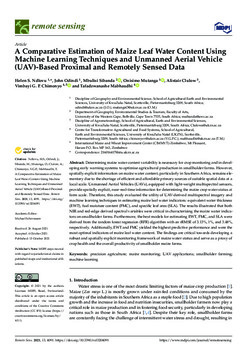Mostrar el registro sencillo del ítem
A comparative estimation of maize leaf water content using machine learning techniques and unmanned aerial vehicle (UAV)-based proximal and remotely sensed data
| Creador: | Ndlovu, H.S. |
| Creador: | Odindi, J. |
| Creador: | Sibanda, M. |
| Creador: | Mutanga, O. |
| Creador: | Clulow, A.D. |
| Creador: | Chimonyo, V.G.P. |
| Creador: | Mabhaudhi, T. |
| Año: | 2021 |
| URI: | https://hdl.handle.net/10883/21718 |
| Lenguaje: | English |
| Editor: | MDPI |
| Copyright: | CIMMYT manages Intellectual Assets as International Public Goods. The user is free to download, print, store and share this work. In case you want to translate or create any other derivative work and share or distribute such translation/derivative work, please contact CIMMYT-Knowledge-Center@cgiar.org indicating the work you want to use and the kind of use you intend; CIMMYT will contact you with the suitable license for that purpose |
| Tipo: | Article |
| Lugar de publicación: | Basel (Switzerland) |
| Número: | 20 |
| Volumen: | 13 |
| DOI: | 10.3390/rs13204091 |
| Palabras Claves: | Maize Monitoring |
| Descripción: | Determining maize water content variability is necessary for crop monitoring and in developing early warning systems to optimise agricultural production in smallholder farms. However, spatially explicit information on maize water content, particularly in Southern Africa, remains elementary due to the shortage of efficient and affordable primary sources of suitable spatial data at a local scale. Unmanned Aerial Vehicles (UAVs), equipped with light-weight multispectral sensors, provide spatially explicit, near-real-time information for determining the maize crop water status at farm scale. Therefore, this study evaluated the utility of UAV-derived multispectral imagery and machine learning techniques in estimating maize leaf water indicators: equivalent water thickness (EWT), fuel moisture content (FMC), and specific leaf area (SLA). The results illustrated that both NIR and red-edge derived spectral variables were critical in characterising the maize water indicators on smallholder farms. Furthermore, the best models for estimating EWT, FMC, and SLA were derived from the random forest regression (RFR) algorithm with an rRMSE of 3.13%, 1%, and 3.48%, respectively. Additionally, EWT and FMC yielded the highest predictive performance and were the most optimal indicators of maize leaf water content. The findings are critical towards developing a robust and spatially explicit monitoring framework of maize water status and serve as a proxy of crop health and the overall productivity of smallholder maize farms. |
| Agrovoc: | PRECISION AGRICULTURE |
| Agrovoc: | CROP MONITORING |
| Agrovoc: | UNMANNED AERIAL VEHICLES |
| Agrovoc: | SMALLHOLDERS |
| Agrovoc: | MACHINE LEARNING |
| ISSN: | 2072-4292 |
| Revista: | Remote Sensing |
| Número de artículo: | 4091 |
Ficheros en el ítem
Este ítem aparece en la(s) siguiente(s) colección(ones)
-
Sustainable Intensification
Sustainable intensification agriculture including topics on cropping systems, agronomy, soil, mechanization, precision agriculture, etc.

